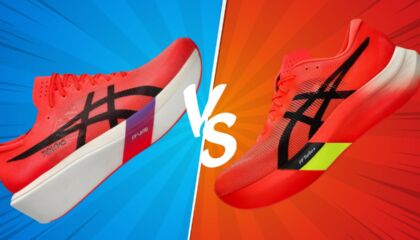


The Nike Pegasus is one of the most popular neutral trainers in the world because it is so versatile and it has a consistent fit from update to update. Now in its 41st iteration, it has received a brand new upper, midsole and outsole.
The Structure used to be Nike's most popular stability trainer but the 25th iteration of the Structure is no longer a stability trainer with a medial post. The Structure also has a Zoom Air unit in its forefoot and is now more cushioned and more plush.
Which one of these trainers is for you?
The midsole of the Pegasus is made of ReactX foam which Nike calls their most “complete” foam. It rides medium firm which means that it can be used for tempo runs, marathon-paced runs and even long, slow runs.
The midsole of the Structure is made from a new foam called Cushlon 3.0. It rides medium soft which means that it is suitable for slow runs, recovery runs or slightly faster runs.
Inside the midsole of the Pegasus is a large, thick forefoot Zoom Air unit which adds a springy sensation to the ride of the Pegasus thus increasing responsiveness. There is an additional air unit in the heel for extra cushioning.
The Structure also has a Zoom Air unit in the forefoot but it is smaller and thinner than the air bag in the Pegasus. The smaller air bag is situated under the ball of the foot and the outline can be felt underfoot which some runners may find lumpy.
The Structure is a neutral trainer but has stability features which make it very stable. It has a built up medial-side which prevents over pronators from excessive inward rolling of the ankle as well as a midsole with a large, wide base.
The Pegasus is firmer than the Structure but it still has a lower level of stability.
Ride transitions are smoother in the Pegasus than in the Structure due to the air bag implementation. In the Structure, you can feel the outline of the air bag underfoot which feels slightly lumpy. In the Pegasus, the air bag is so large that it takes up the entire forefoot so you can’t feel the outline of it.
Both outsoles have plenty of thick, durable rubber. They have harder carbon rubber on the heel areas with softer, blown rubber on the forefoot and midfoot. Both trainers have lateral crash pads to absorb shock during foot strikes.
The main difference between the flexibility of the two trainers is the Structure has a smaller forefoot air bag and this results in a more flexible, less snappy Structure forefoot. The Pegasus’s forefoot snaps back into place very quickly which is better for faster runs.
The Pegasus has a comfortable upper with a padded tongue attached to an inner sleeve. It is available in wide and extra wide versions. It has a shallow heel counter but doesn’t leads to heel slippage.
The Structure has a plush upper with plenty of foam padding in its tongue and heel collar. The Structure’s upper was designed for long-distance comfort but it isn’t suited to warm climates because all the padding absorbs sweat. There is an internal heel counter in the Structure and heel lockdown is great.
If you’re a runner looking for a more versatile daily trainer which can do more types of runs, the Pegasus is a great choice. It has a large Zoom Air bag in its forefoot which provides excellent responsiveness and a snappy forefoot.
If you’re a runner looking for a daily trainer for mainly easy or recovery runs, the Structure is the shoe for you. The Structure has a plush, comfortable upper with great foot lockdown and has better stability than the Pegasus. It is a heavier shoe but has a lot more cushioning than the Pegasus.